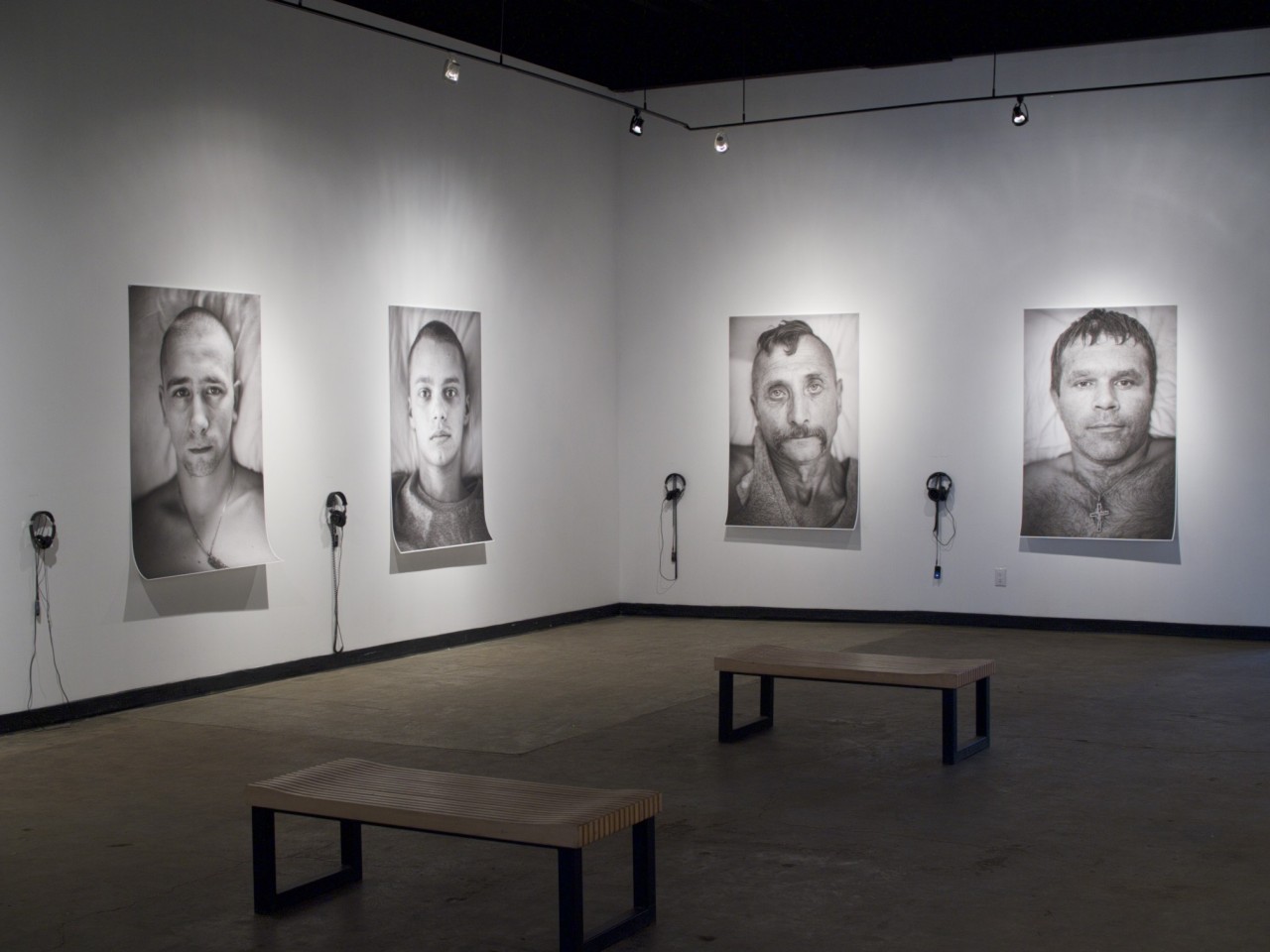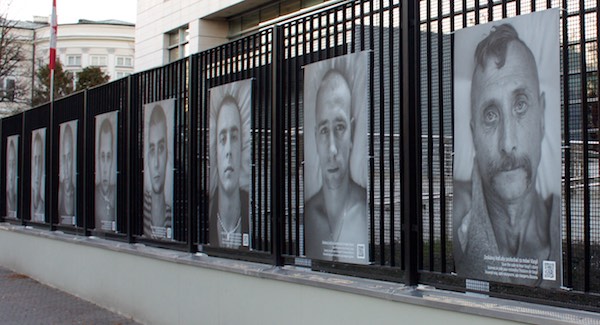Taras Polataiko | War. 11 Portraits
March 24—April 30, 2016
Opening reception: Thursday, March 24 at 7 pm
Artist Talk | Saturday, March 26 at 2pm
“The raging war made it impossible to focus on anything else.”
Ukrainian-Born Canadian artist Taras Polataiko returned to Kyiv to create a project on the eve of the annexation of Crimea. Known for painting, sculpture, and intermedia projects with performance, bodily fluids, and exploration of media, Polataiko ended up making portrait photographs of wounded soldiers in hospital, coupled with interviews about their experiences, recording them in one take interrupted occasionally by nurses offering anaesthetic shots. He asked only one question: what is needed here?
What does Polataiko’s gaze of war ask of us?
“You look him in the eye and you listen to what he has to say. Simple as that.” —Taras Polataiko
“The eyes are organs of asking.” —Paul Valéry
Central and Eastern Europeans have no problem knowing how to respond to this latest artwork by Taras Polataiko, but in the West, war is a slippery subject for contemporary art. Photojournalism’s descriptive ethos is believed to be distinct from art’s ethos of beauty therefore any attempt to “aestheticize” a reality like war becomes morally suspect. Yet aesthetics are at the root of how we see, perceive and give form to the world, and every war actually has its own aesthetics. Today’s wars even have their own “insta-aesthetics” tweeted at you live via soldier-selfies on social media.
Images of war tend to divide reactions into: does it glorify or critique war? War is dichotomous by nature—there are two sides, past and present injustices, historical perspectives, truth and propaganda. Images of war leave viewers feeling conflicted, perhaps out of moral necessity. What if the artwork seeks a third experience? Taras Polataiko photographed and recorded 11 seriously wounded Ukrainian soldiers—survivors of Russia’s ongoing invasion and occupation of Ukraine—in the surgical wing of Kyiv’s Main Military Clinical Hospital. In his exhibition War. 11 Portraits, he compels us to look these soldiers in the eye and listen to what they have to say. But to understand the aesthetics of a Polataiko artwork, one needs to equally understand the unseen context that informs it, to grasp those aesthetics from the inside out.
For Ukrainians, war is a concrete human experience and responding with full commitment is necessary for survival. The Kremlin’s decision to intervene militarily in Ukraine is part of a larger policy to destabilize the European Union and hit at the global institutional order. The war in Ukraine is thus not really about Ukraine, but about undermining Europe and Western democracies, and it poses a serious and direct philosophical challenge to the West. The crisis is not just in “losing” Eastern Europe, but about Europe losing itself. Ukrainians are the first people in history to shed blood for the idea of Europe; Ukraine is de facto the West’s buffer zone. What happens in Ukraine is vital for the survival of the post-cold war international order.
Snipers and artillery work daily in eastern Ukraine. On February 24 2016, 56 battles waged. Dozens of villages are ravaged or abandoned in ruins and 1.5 million Ukrainians are refugees inside their own country as a result of Russian annexation of Crimea and the invasion of eastern Donbas. The narrative for the war on Ukraine was scripted in Moscow and enacted by state television channels who substitute fiction for reality, resulting in severe wounding and death. There are well over 9,000 dead despite the Minsk I & II Agreement ceasefires. The Donbas region simmers in a state of highly militarized limbo ready to flare; Russian proxy formations on these occupied territories now have one of the best armies in Europe, lacking only airpower. As of the first week of February, Ukraine’s President informed that 2,269 Ukrainian soldiers have died since the invasion began in the spring of 2014. This is a number just shy of the total US troops killed in 14 years of Afghan combat, and higher than the yearly average of American troops killed in Iraq.
That high a rate itself shows the seriousness of the war in Ukraine, yet most in the Western world pay it little attention or are willingly susceptible to the Kremlin’s colonialist propaganda onslaught. Tens of thousands are severely wounded as dual or triple amputees, with missing sections of skull or without an eye or jaw. Ukraine bleeds under constant shelling, and while “We Are Paris,” “we” are never Ukraine globally. There is only a muted response from the Western world to the traumatic events of Russia’s war on Ukraine, and the Kremlin’s disinformation is designed to delay any response that much longer.
In all of this, no one ever asks Ukrainians what they think. Russian and Western commentators alike implicitly deny Ukraine the dignity of being an active subject in its own history, relegating Ukraine to the non-status of being neither a country, nor a language nor a distinct nation of peoples, but a geopolitical play toy under a superior power’s ‘sphere of influence’ (Russian President Putin) in which the West ‘must dare not interfere’ (Russian Foreign Minister Lavrov). This Orientalist colonialist conceit—that only a former (imperialist) power can be an actor in a region—keeps trying to silence Ukraine’s intensifying voice of dissent. By directing us to hear their voices and listen to their stories while looking them in the eye, Polataiko insists on their agency in the conflict and in the world, giving the lie to the colonialist attitude resuscitated in dreams of a Eurasian Union. By calling his photo series “War,” Polataiko accomplishes what the Ukrainian government wasn’t able to. The government dubbed it an “Anti-Terrorism Operation” (ATO) because it cannot be recognized internationally without escalation, nor can a state of emergency be declared. Nonetheless, it is a real war of tanks, planes, drones and heavy arms. So how does one respond as an artist when a part of one’s homeland is submerged in a war of invasion that history books haven’t seen since WW2?
The soldiers lie bare chested in bed, or in undershirts and tees without military trappings, only plastic crucifix and other necklaces; their wounds not visible beyond eyebrow stitches and subclavian catheters. Although some are recent double amputees, Polataiko doesn’t envision them as wounded soldiers. They look empowered and masculine despite their bedbound vulnerability; a sense of their agency in the world is projected, their casualties awarded full dignity. They are shot from above in a camera angle looking down at them lying in bed. When this horizontal perspective is placed vertically on a wall, a “slightly off” tension results between how we normally read reality and how we perceive their gaze leveled back at us. As viewers we read this as slightly looking down on the soldiers. This somewhat lofty perceptual dislocation parallels how the West views the non-West.
Yet their penetrating gazes more than match ours, locked in mutual scrutiny. This is the space in which viewers negotiate the aesthetics of the artwork for themselves. Polataiko understands this charged space between viewer and contextualized subject well; he’s masterful at setting up that context to mine its depths. These are portraits of faces too young to have to kill or too old to be scrambling through battlefields, regular men from all walks of life whose eyes reflect a slightly haunted and weary, quietly determined, unashamed face of war. With how many front line war vets do we ever exchange as sustained a gaze?
The monumental photos are black and white, a distancing filter giving viewers a chance to step back and contemplate a moment already historicized yet seemingly symbolic and prevailing. Indeed, since being photographed one of the men, Serhiy (call sign “Dynamite”), is now dead. He returned to the ATO zone and was killed in action. “This is a land you can give your soul for, your very life and soul,” we poignantly hear him say. Another, Oleh, is still in hospital in Barcelona for a treatment not possible in Ukraine. He has 8 cm of pelvic bone missing yet wants to return to the ATO. If you read their stories via translation, language creates another filter. These 11 war portraits are keenly about the uncomfortable distances connecting viewers and subjects perceiving each other wherever they show globally. Personally we feel aware of a debt of gratitude owed veterans in any country—yet on the global level, the West has never included Ukraine despite Ukraine’s integral part in European history. The loaded terrain of our gaze levelly returned by theirs synthesizes into a richly charged encounter. All our perceptions and misperceptions travel along that exchanged gaze.
The audio portraits tell each individual soldier’s story, while taken together, depict a portrait of the previous governments’ dismantling of Ukraine’s military begun 22 years ago after the signing of the Budapest Memorandum, showing state structures that fail to respond or respond inadequately to the needs of each battalion thrown unprepared into war. Almost every soldier lists a litany of basic defense needs: helmets, bulletproof vests, medical kits, adequate uniforms, thermal imagers, night vision scopes, and food. To date, it is Ukraine’s indomitable armies of civil society volunteers that have supplied the bulk of these desperate needs through individual fundraising initiatives. Polataiko himself went to Kyiv to work on another project but because of the war, couldn’t focus and made this instead, envisioning it primarily as a fundraiser for army needs.
Art has capacity to make palpable what is difficult to see. These 11 portraits are not just of wounded soldiers, but a condition of being. Their presence questions the hypocritical Western borders that harbour kleptocratic power elites whose social orders perpetuate wars. Observe how the photos encircle crowded galleries of wine-drinking viewers chatting at openings, their eyes overhead steadily gazing back at us like a mirror.
The aesthetics of this work ask us to grapple with this bigger picture, so readily understood by the soldiers, which implicates us in the West. What is unspoken in their eyes, the horrors of war these men have suffered, witnessed, and live with, is the frank truth of their being, their agency within this impossible web—and their truth is what is at stake here. To grasp the larger truth is to acknowledge that this is the West’s war too and they are our front lines. The portraits stand as an intervention into the occupier’s ongoing colonialist rhetoric and force a dialogue between a dismissive regionalism and the social and international issues at the fore of this global contemporary discussion. If we continue remaining passive, will we ever be able to look them in the eye, to listen, and to acknowledge the portrait of war they embody?
—Sophia Isajiw Toronto, March 11, 2016
-
Sophia Isajiw is an artist, writer, curator, and university professor. Her works are in the collections of The Canadian Museum of Civilization, The Glenbow Museum of Art, The Whyte Museum of the Canadian Rockies, The Walter Phillips Gallery, and The Canada Council Art Bank.
Isajiw has served as Director and Curator of the California State University’s Art Gallery at Stanislaus, directed the Print & Paper Media facilities at the Banff Centre for the Arts, and is the author of numerous exhibition catalogue essays in the USA and Canada. Isajiw is Founding Editor of the Voices of Ukraine blog, and Interviewer for the Children of Holodomor Survivors Speak Oral History Project at the Ukrainian Canadian Research and Documentation Centre



